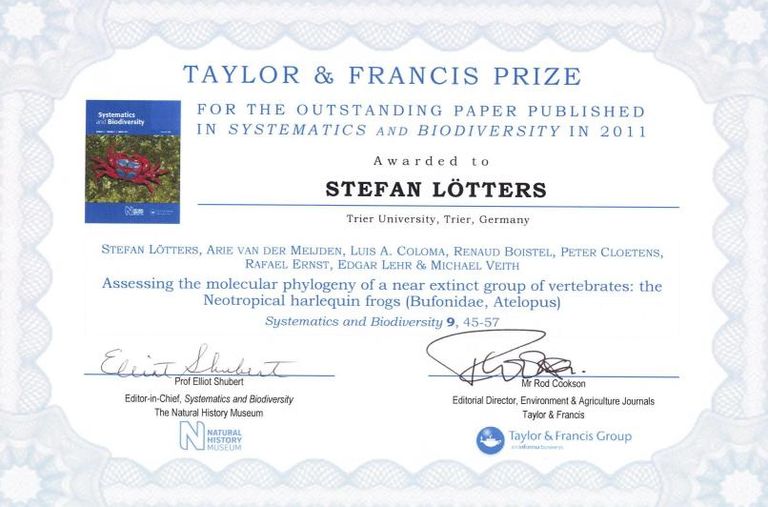Lab News and Research Highlights
Updated in March 2023
Wildlife diseses should not be ignored
17 March 2023
Wildlife diseases pose an increasing threat to global bioiversity. An example is the spreading salamander plague. It is caused by the amphibian skin fungus Bsal leading to skin damages and letal infections in European fire salamanders (photo by M Vences).
The recent UN Biodiversity conference (COP 15) held in December 2022 in Montreal, with its 4 goals and 23 targets, simply ignored the threat though wildlife diseases! In a Letter to Science, we claim that disease mitigation should be considered as an important aspect to combat wordlwide biodiversity loss!
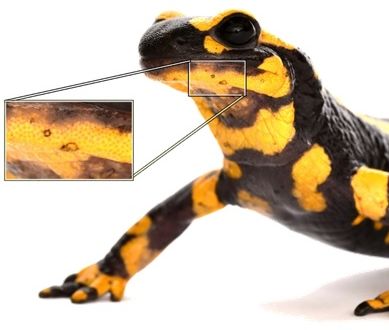
Rediscovered after 35 years: Pebas harlequin toad
1 February 2023
Atelopus spumarius was described by Cope in 1871 based on 2 specimens from Pebas in Amazonian Peru. Only less than a dozen of individuals has been reported since, latest when an expedition by the American Museum of Natural History in New York traced it in 1977. For the last 20 years we have been behind this enigmatic amphibian. In various expeditions we tried to find it but could not find it, until recently a team led by Stefan Lötters, Philipp Böning, Amadeus Plewnia, Jaime Culebras, Angel Chujutalli and colleagues discovered a population not far from Pebas town.
The rediscovery is important as it helps placing A. spumarius into molecular-based phylogenies. In this way, we are now able to identify new species! There are various populations in the upper Amazn basin that look like A. spumarius but actually do represent distinct - cryptic - species that do not have scientific names yet. Naming them is only now possible with information on the 'true' A. spumarius. Coining names for the undescribed species is an important step towards eventually better protecting them.
Protecting harlequin toads is an important issue, as these amphibians are dramatically declining. Learn more about this from the Atelopus Survival Initiative (ASI).
Sadly, the rediscovered population of the Pebas harlequin toad is already enfangered through the expansion of the town.
Photo copyright: Jaime Culebras
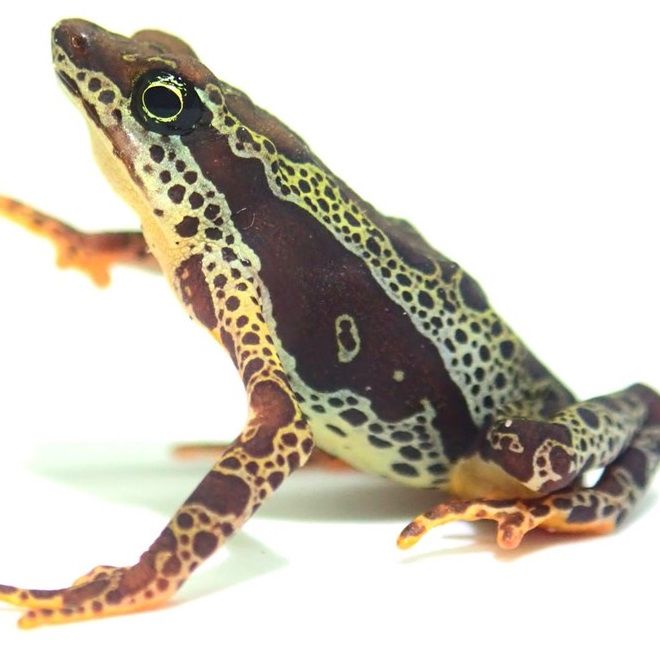
Field work in Colombia
1 October 2022
This summer, members of our group visited various sites in the Colombian Cordillera Occidental where formerly harlequin frogs (Atelopus) occurred. They are among the most threatened of all amphibians (see here: Atelopus Survival Initiative). Many of the > 100 species have not been seen for many years.
Although perhaps expected, it was a quite frustrating result was that we have not been able to trace any of the species. Let's hope they are still there and we our other conservationists can find them.
We found many other interesting herps of course and met with our Colombian colleagues to discuss on-going and future projects. We also visited the scientific collections of Universidad del Valle, Instituto Alexander von Humboldt and Instituto de Ciencias Naturales to learn more about the Atelopus from western Colombia. One of the species studied in preservative was Atelopus chocoensis (see enlarged figure).
Photo copyright: Christopher H. Heine, Jaime Culebras
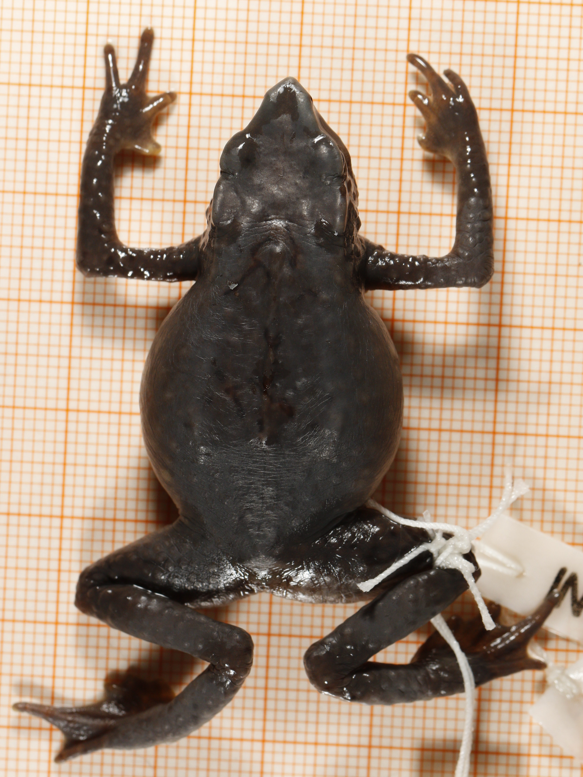
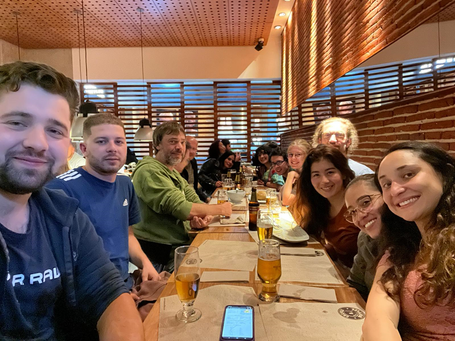
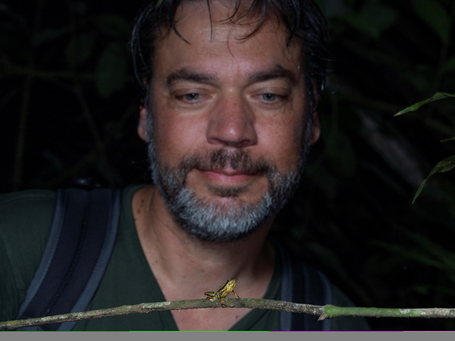

A Research Milestone on the Status of the "Salamander Plague" in Germany
20 August 2020
The salamander plague, caused by the Asian invasive chytrid fungus Batrachochytrium salamandrivorans (Bsal), poses a serious threat to the amphibian diversity of Western Europe. Apparently, Germany is a Bsal hotspot with most (!) of all known European records to date and massive spreads in recent years.
Bsal literally 'eats' the salamander's skin and causes destruction (typically small circular lesions, see photo). Animals die of secundary infection then.
Recently, an open access online issue of the German herpetological journal Salamandra dedicated to Bsal in Germany was published. It contains 11 publications summarizing the current knowledge. Guest editors are Miguel Vences and Stefan Lötters.
Photo copyright: Miguel Vences
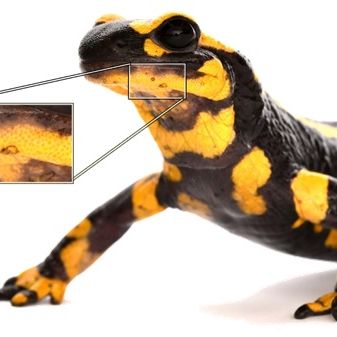
Long-Distance Dispersal in Amphibians Reviewed
31 December 2019
Long-distance dispersal (LDD) involves movements outside the standard geographic limits and outside the genetic neighbourhood area of individuals. Although considered ‘rare’, LDD is important to amphibians at the population, species and community levels. To understand how LDD shapes current biogeographic patterns in these tetrapods, Luis F. Marin da Fonte and co-authors, in Frontiers of Biogeography, reviewed the cases reported in the literature.
In 41 studies, we recovered at least 90 LDD events (3 active, 87 passive) involving at least 56 extant species and 38 genera. Most events (73) involved the colonization of islands, with rafting being suggested as the most conceivable means of overwater passive dispersal for these vertebrates. We show that LDD events have played a significant role in shaping current amphibian biogeographic patterns, especially the occurrence of disjunct distributions and the colonization of islands.
Marin da Fonte, L.F., M. Mayer & S. Lötters (2019): Review: Long-distance dispersal in amphibians. — Frontiers in Biogeography, 11.4: e44577.
The Atelopus Survival Initiative
25 November 2019
The Neotropical toad genus Atelopus, also known as harlequin toads, contains more than 100 species. The majority of them is seriously threatened with extinction, making Atelopus one of the most threatened vertebrate genera. Global Wildlife Conservation, in collaboration with the IUCN SSC Amphibian Specialist Group, Amphibian Survival Alliance, Amphibian Ark, Panama Amphibian Rescue and Conservation Project, and others, is spearheading efforts to develop and foster a coordinated harlequin toad conservation network - the Atelopus Survival Initiative (ASI).
The network includes national and international players - conservation groups and zoos, academic institutions and governments - working together to implement substantial, long-term, range-wide conservation measures for these unique amphibians. A kick-off meeting was held in Medellín, Colombia, 4-7 November 2019., including two lab members, Stefan Lötters and Luis F. Marin da Fonte.
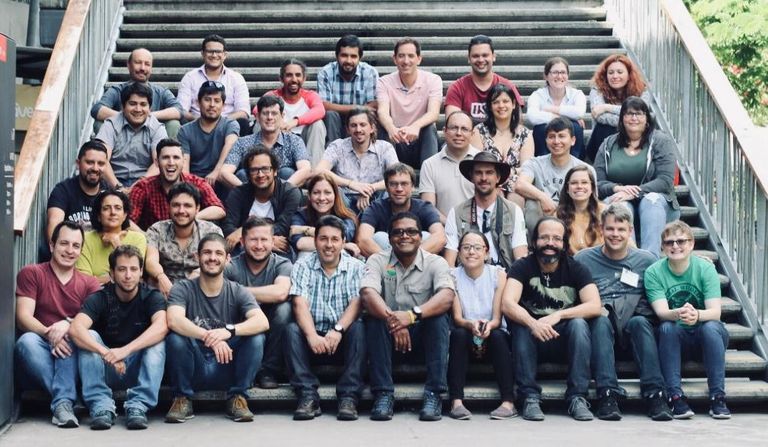
And the Winner is...
1 September 2019
Daniela Rößler --- she won the first price of this years' poster award related to the 20th Congress of European Society for Evolutionary Biology (ESEB) in Turku, Finland, 19-24 August 2019. Watch the poster Predator identification from salivary DNA left on artificial prey (by Rößler, D., S. Lötters, M. Fugmann, M. Veith & H. Krehenwinkel) in full size on Research Gate.
What is it about?
Predator-prey interactions are a vast field in ecological research and many mechanisms thereof are crucial to understand natural selection, trait functions, cognition of traits and hence their evolution. However, for many taxa predator-prey interactions are difficult to study because field observations of predation events are rare. Predation is based on perception of stimuli, in many cases visual cues. To understand the effects of different visual cues on predation, such as coloration or patterns of prey animals, many studies use artificial prey to collect information. Although widely deployed, this method largely lacks standardization of attack identification. In a new approach, we tested whether DNA of predators can be isolated from bite and peck marks found on clay models to ultimately allow precise and robust identification of the attacker. In a pilot study, we placed more than 800 models of European fire salamanders (Salamandra salamandra) in the field to collect information on predation. Attack marks on models were first analyzed visually. Subsequently, we successfully isolated and sequenced DNA of more than 6 different species of attackers from the marks left on clay models. Our results not only underline the problem of misidentification of attacks by vision alone, but also offer an intriguing method to gain robust data on predators of artificial prey. Furthermore, the method opens up new possibilities beyond the standard use of clay model studies to date, including a potential use in invasive species monitoring and species inventories.
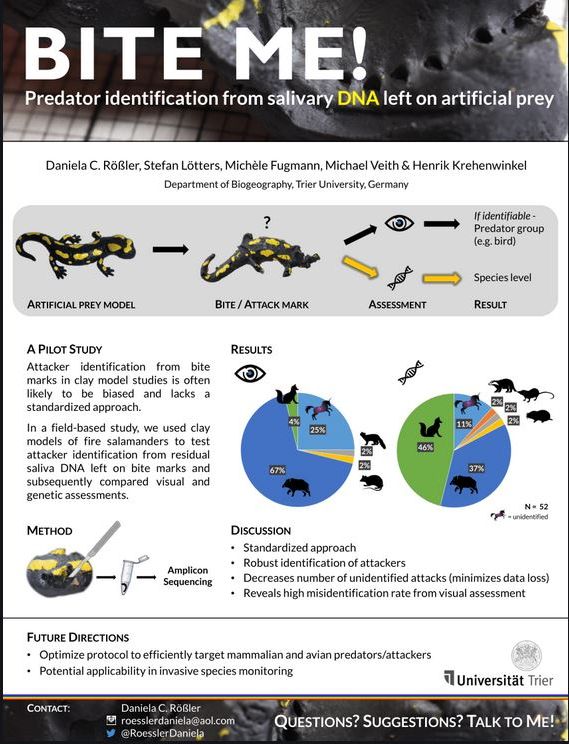
These Soles are Made for Walking
5 February 2019
The diversity of strategies by animals to avoid predation is fascinating. We studied diurnal, toxic harlequin toads, Atelopus spumarius sensu lato, from the Amazon basin. In this species complex, some populations have striking red soles of the hands and feet, visible only when walking (see video). When stationary, the toads are hard to detect. Consequently, these toads switch between high and low conspicuousness. Interestingly, some populations lack the extra colour display of the soles.
In a recent study, lead by Daniela Rößler and published in Scientific Reports, we found comprehensive support that the red coloration can act as an warning signal directed towards potential predators: red soles are significantly more conspicuous than soles lacking red coloration to bird predators and the presence of the red signal significantly increases detection. In line with this, toads with red soles show bolder behaviour by using higher sites in the vegetation than those lacking this signal. Field experiments hint at a lower attack risk for painted frog clay models with red soles than for those lacking the signal, in a population where the red soles naturally occur.
If advantageous, why red soles are absent in some Atelopus populations? Signal lack (evolutionary loss?) may be explained by a higher overall attack risk or potential differences of predator community structure between populations.
Rößler, D.C., S. Lötters, J. Mappes, J.K. Valkonen, M. Menin, A.P. Lima & H. Pröhl (2019): Sole coloration as an unusual aposematic signal in a Neotropical toad. — Scientific Reports, 9: 1128.

New Alarming Discovery: Co-infection of Chytrid Fungi on Amphibians
22 December 2018
Emerging fungal diseases are increasingly contributing to the global biodiversity crises. Among the most blatant is chytridiomycosis in amphibians. It can be caused by 2 species of chytrid skin fungi, Batrachochytrium dendrobatidis (Bd) and B. salamandrivorans (Bsal). We for the first time ever found that both fungi can parasite on the same host individual. Of 22 fire salamanders (Salamandra salamandra) found dead at the "Belgenbach", Eifel (Germany), 21 had Bsal and 16 of them additionally Bd.
This is alarming news! In a recent paper we discuss that multi-parasitism can have effects on host susceptibility, infection duration, transmission risk and clinical symptoms. Moreover, 'horizontal gene transfer', already known from Bd and other fungi, may increase pathogen virulence.
On the other hand, pathogen interaction can also be antagonistic. Moreover, among nearly another 500 fire salamanders from all over Germany Bd - besides its wide geographic spread of Europe - was almost entirely absent. Bsal was confirmed in about 70 of them. Bd/Bsal co-infection definitvely is one of the many research fields in amphibian conservation which urgently need attention!
Lötters, S., N. Wagner, A. Kerres, M. Vences, S. Steinfartz, J. Sabino-Pinto, L. Seufer, K. Preißler, V. Schulz & M. Veith (2018): First report of host co-infection of parasitic amphibian chytrid fungi. — Salamandra, 54: 287-290.
The Future of Clay Model Studies
13 July 2018
Predator-prey interactions can be addressed using clay models of prey animals. These are placed in the field to test the predator’s behavior: attack, avoid or whatever?
Our lab uses clay models to learn more about the function of warning signals in toxic amphibians. For instance we test if attack rates change if a novel signal is involved, such as when in real yellow-black fires salamanders are suddenly blue and black ('fake news' so to say). For various reasons clay model studies are really tricky. In a recent BMC Zoology paper, Rößler et al. comment on such studies in the future including the use of proper (non-toxic) clay materials, standardization and next generation clay model studies.
Rößler, D.C., H. Pröhl & S. Lötters (2018): Commentary: the future of clay model studies. — BMC Zoology, 3: 6.
James Bond of Biodiversity
17 February 2018
The license to kill - are we allowed to drive species to extinction that are transmitters of serious diseases? At least we do so: In the “Pan African Tsetse and Trypanosomiasis Eradication Campaign,” we aim at eradicating the pathogen Trypanosoma via eradication of its vector: tsetse flies. Is this justified, can we decide a species is 'good' or 'bad'? How does this meet with our general goal to globally safeguard biodiversity? We come to the conclusion that disease eradication programs may not be in line with the Convention on Biological Diversity (CBD), which we discuss in a recent policy perspective by Hochkirch et al. in Conservation Letters. The 'License to Kill' might be exclusive to Mr. James Bond in another mission.
Hochkirch, A., J. Beninde, M. Fischer, A. Krahner, C. Lindemann, D. Matenaar, K. Rohde, N. Wagner, C. Wesch, S. Wirtz, A. Zink, S. Lötters, T. Schmitt, A. Proelss & M. Veith (2018): License to kill? – Disease eradication programs may not be in line with the Convention on Biological Diversity. — Conservation Letters, 11: 1-6
De-Extinction, Nomenclature and the Law
9 June 2017
This week, our group was involved in a policy forum article in Science. People from the Department of Biogeography and the Institute of Environmental and Technology Law of Trier University contributed to this paper by Norman Wagner and colleagues.
Our policy piece deals with de-extinction of animal species which no longer exist on our planet, such as mammoths species. New techniques - back-breeding, cloning, and genomic engineering - now provide the opportunity to attempt to resurrect extinct species. We discuss implications for conservation laws, which largely depend on zoological nomenclature, and laws regarding the release of genetically engineered species, which do not, and argue for unique naming of de-extinct species.
Wagner, N., A. Hochkirch, H. Martin, D. Matenaar, K. Rohde, F. Wacht, C. Wesch, S. Wirtz, R. Klein, S. Lötters, A. Proelss & M. Veith (2017): De-extinction, nomenclature, and the law. — Science, 356: 1016-1017.
Joint European Forces to Mitigate Problems from Salamander Fungus
30 March 2017
Under the lead of Gent University / BE, the European Commission has granted EUR 900,000
for 36 months for the project "Mitigating a new infectious disease in salamanders to counteract
a loss of European biodiversity" (No 07.027731/2017/750768/SER/ENV.D.3.). Apart from
Trier University / GER, the following institutions from six countries are partners: Stichting Reptielen Amfibieën Vissen Onderzoek Nederland (RAVON) / NL; Centre National de la Recherche Scientifique (C.N.R.S.) / F; Universita degli Studi di Genova (UNIGE) / I;
Zoological Society of London / UK; Agencia Estatal Consejo Superior de Investigaciones
Cientifica (CSIC) / ES; NATAGORA / BE.
The goal of this international research project is to collect data at the large scale to better understand the epidemiology of the dangerous salamander fungus, Batrachochytrium salamandrivorans (Bsal) – and to eventually stem the expected tide of amphibian population declines and prevent mass extinctions. A webpage informs about the project.
The part of Trier University is to provide information on the presence/absence of Bsal in Germany. For this purpose, we sample fire salamanders (Salamandra salamandra) at 50 localities all over Germany. We swab up to 30 live individuals per site and subsequently use quantitative real time PCR (polymerase chain reaction) to test for Bsal infections. Like all partners in this project we use the same standard protocols.
In addition, we run a Bsal hotline (+49 - 651 - 201 4174) for emergency contact in case of observed salamander declines.
Salamander Fungus Research Goes On
15 March 2017
The salamander fungus, Batrachochytrium salamandrivorans (Bsal), has been identified as a serious threat to the amphibian diversity of the Western Palearctic. It is suggested that this pathogen is of Asian origin and has been introduced into Europe some years ago, with records so far known from Belgium, Germany and the Netherlands. Apparently, Bsal is spreading in the wild, e.g. the "Eifel" in Germany. We have now developed a first epidemiological model that explores the effects of Bsal on host populations (fire salamander). The model suggests that disease outbreaks can occur at very low host densities so that natural populatiosn are at high risk of severe decline - or extinction. The research was conducted in collaboration with colleagues from Braunschweig and Zurich Universities and with the expertise of Wildlife Analysis GmbH, Zurich.
Apart from these theoretical efforts, our field-based research and monitoring will continue from 2017 on. We have recently been able to obtain grants by the German Federal Agency for Nature Conservation (Bundesamt für Naturschutz) and the European Commission Directorate-General Environment.
Schmidt, B.R. C. Bozzuto, S. Lötters & S. Steinfartz (2017): Dynamics of host populations affected by the emerging fungal pathogen Batrachochytrium salamandrivorans. — Royal Society Open Science, 4: 160801.
Dangerous Salamander Fungus Spreads...
1 November 2016
For some years now, we have to struggle with a new amphibian pathogen in Europe, the skin-eating salamander fungus, Batrachochytrium salamandrivorans (Bsal). It kills salamanders and newts. Especially the Fire salamander is affected, while frogs and toads seem fine with Bsal. Apparently of Asian origin, there is evidence that Bsal is now emerging in its invasive European range, although this is not proven with certainty yet. Bsal is considered a serious threat to Western Palearctic amphibian diversity.
Our ongoing research — in collaboration with Biostation Aachen, Biostation Düren, Braunschweig University, Ghent University, RAVON, and others — has yielded 14 of 55 studied sites as Bsal-positive in Belgium, Germany and the Netherlands. In some of these, Bsal was not detected on earlier occasions. Read more in our scientific publication by Spitzen van-der-Sluijs et al. (2016). For updates and most recent Bsal findings, we recommend the webpage of RAVON.
Because of the threat by Bsal and to aid mitigation strategies and conservation action, we for the first time have modelled the potential distribution of this fungus for the region where it is so far recorded in Europe. In this study, we created various models with different data and assumptions. As a novelty, we also incorporated fine-scale weather data, which allowed us to emphasize predictors in accordance with the known pathogen's biology. In this way, we were able to appreciate Bsal's invasion potential in geographic space and to identify areas which are of high invasion risk, such as the Black Forest.
Spitzen-van der Sluijs, A., A. Martel, J. Asselberghs, E.K. Bales, W. Beukema, M.C. Bletz, L. Dalbeck, E. Goverse, A. Kerres, T. Kinet, K. Kirst, A. Laudelout, L.F. Marin da Fonte, A. Nöllert, D. Ohlhoff, J. Sabino-Pinto, B.R. Schmidt, J. Speybroeck, F. Spikmans, S. Steinfartz, M. Veith, M. Vences, N. Wagner, F. Pasmans & S. Lötters (2016): Expanding distribution of lethal amphibian fungus Batrachochytrium salamandrivorans in Europe. — Emerging Infectious Diseases, 22: 1286-1288.
Feldmeier, S., L. Schefczyk, N. Wagner, G. Heinemann, M. Veith & S. Lötters (2016): Present and future high risk zones for the spreading lethal salamander chytrid fungus in its invasive range in Europe using bioclimate and weather extremes. — PLoS ONE, 11: e0165682.
Diversification and Niche Conservatism in an African Frog Since the Miocene
23 October 2016
The Mascarene ridged frog (Ptychadena mascareniensis species complex) is known from many humid savannas and open forests of mainland Africa, Madagascar, the Seychelles and the Mascarene Islands. In a recent study (Zimkus et al. 2017), by multiple collaborators, we demonstrate high levels of genetic differentiation with ten distinct lineages, and that Central Africa is diversity hotspot for these frogs. Further, we show that most speciation took place throughout the Miocene, including 'Out-of-Africa' overseas dispersal. Interestingly, the bioclimatic niche was remarkably well conserved, with most species tolerating similar temperature and rainfall conditions common to the Central African region. The P. mascareniensis complex provides insights into how bioclimatic niche shaped the current biogeographic patterns with niche conservatism being exhibited by the Central African radiation and niche divergence shaping populations in West Africa and Madagascar.
Zimkus, B.M., L.P. Lawson, M.F. Barej, C.D. Barratt, A. Channing, K.M. Dash, J.M. Dehling, L. Du Preez, P.-S. Gehring, E. Greenbaum, V. Gvoždík, J. Harvey, J. Kielgast, C. Kusamba, Z.T. Nagy, M. Pabijan, J. Penner, M.-O. Rödel, M. Vences & S. Lötters (2017): Leapfrogging into new territory: How Mascarene ridged frogs diversified across Africa and Madagascar to maintain their ecological niche. — Molecular Phylogenetics and Evolution, 106: 254-269.
The DZG "Masterpreis" 2016 Goes to Our Lab
15 September 2016
The German Zoological Society DZG (Deutsche Zoologische Gesellschaft) has awarded Sarah S. Bisanz for her MEd thesis in Biology entitled "Aktivitätsräume von Ameerega trivittata im amazonischen Tieflandregenwald in Peru". In her study, Sarah examined the home range behavior of a Neotropical poison frog at Panguana Biological Fieldstation in a lowland rainforest of Amazonian Peru. Ameerega trivittata is one of our focal taxa when studying evoluton and dispersal of Amazonian biota. Life history information is important when trying to understand historical processes.
Sarah's fieldwork was carried out in 2014. We have repeated the same study in the following year. A scientific publication on the combined results has recently been published, reporting site fidelity over consecutive years and for the first time female home range behavior in Ameerega trivittata, so far only known in males of this poison frog species.
Neu, C.P., S.S. Bisanz, J.A. Nothacker, M. Mayer & S. Lötters (2016): Male and female home range behavior in the Neotropical poison frog Ameerega trivittata (Anura, Dendrobatidae) over two consecutive years. — South American Journal of Herpetology, 11: 149-156.
The Meaning of Colours
30 August 2016
One of our key research topics is the evolution and the function of warning colors (aposematism) in toxic prey. We study Neotropical harlequin frogs, Atelopus spumarius and related forms from the Amazon basin and adjacent areas.
Interesting in these frogs is:
(1) They are all toxic and possess the highly potent tetrodotoxin (TTX), a substance known from many animals including puffer fish (for more information on TTX see our recent Quick Guide in Current Biology). The degree of intra- and interspecific variation is subject to ongoing research.
(2) These harlequin frogs highly vary in dorsal color conspicuousness: some are vividly colored while others are virtually non-aposematic.
(3) Some have colorful ventral sides and some even hand/foot soles. These are red and we consider them to represent flash marks to warn potential predators. Actually, we have been able to show that red hand/foot soles can almost only be seen by birds. In contrast, dorsal colors are seen by a variety of potential predators including crabs. See an interesting video on a crab predation attempt here; the frog in the end is apparently too toxic for the crab.
Recent fieldwork by Daniela C. Rössler and Max N. Lorentz, doctorate candidates of the lab, has been very successful and they are currently analyzing relationships between color conspicuousness and toxicty aspects. For more videos from the field, see here. Harlequin frogs are not the only amphibians with red hand/foot soles. This character is also notable in toads of the toxic genus Melanophryniscus; see here for the extraordinary Melanophryniscus admirabilis, a Critically Endangered species from southern Brazil.
Lorentz, M.N., A.N. Stokes, D.C. Rössler & S. Lötters (2016): Tetrodotoxin in animals. — Current Biology, 26: R870-R872.
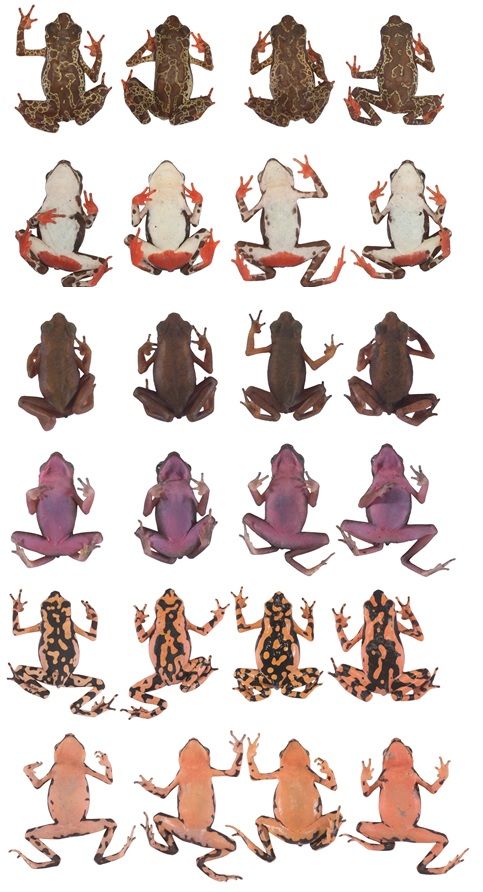
Poison Frog Book
16 May 2016
This new volume with more 500 pages and more than 200 color illustrations (about half of which are detailed scientific drawings) is published in the Conservation International field guide series. It treats all aposematic, i.e. colorful and toxic, species in the poison frog family Dendrobatidae which occur in the Andean countries of South America. This piece of work is the result of a collaborative work by many contributors. It contains information on species' adult and larval morphology, alkaloid profiles, natural history, calls, reproduction, distribution and threats. The book can be obtained from Chimaira.
Kahn, T.R., E. La Marca, S. Lötters, J.L. Brown, E. Twomey & A. Amézquita (2016): Aposemtaic poison frogs (Anura; Dendrobatidae) of the Andean countries Bolivia, Colombia, Ecuador, Peru and Venezuela. — Conservation International, Washington D.C. (USA), 582 pp.
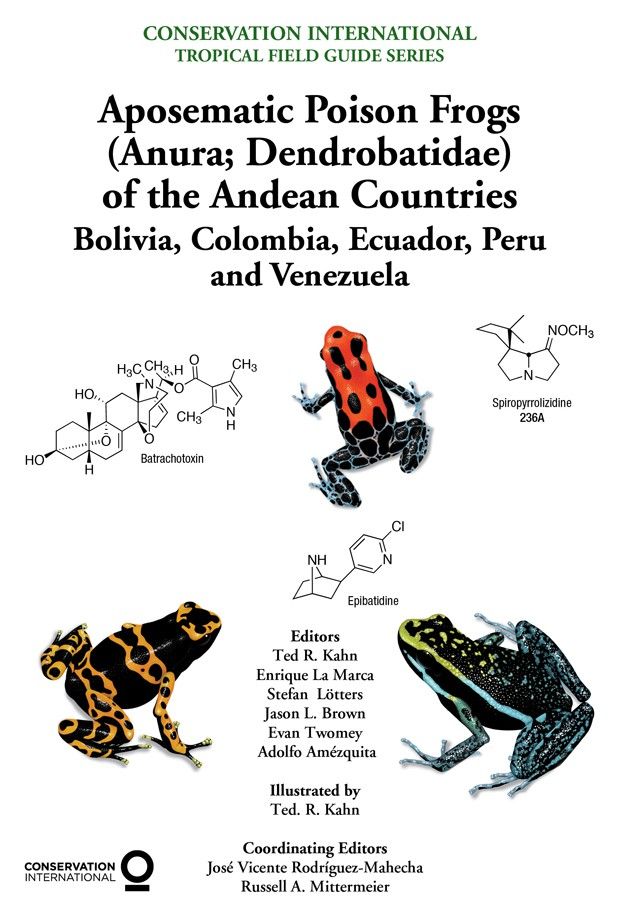
Macroecology Meets Biogeography
17 March 2016
We have recently hosted the first joint conference of the "Arbeitskreis Biogeographie" (VGDH) and the "Arbeitskreis Makroökologie" (GfÖ) (15-17 March 2016). Both macroecology and biogeography, besides their own nature, show a large overlap in topics, concepts and methods. The goal of the scientific meeting was to learn more about the other discipline’s scopes and to identify synergies. We had more than 50 participants from seven countries who found the meeting was a successful cometogether. The program included 26 talks and 5 posters. We are grateful to all participants and to all people from our own department who helped with the organization.
Disentangling Chemical Communication in Poison Frogs: Cues & Signals
1 July 2015
Poison frogs show a complex parental care behavior. Several species lay eggs on land and later transport the tadpoles on one parent's back singly to small water bodies in plants (phytotelms). For some years now, it is known that Ranitomeya variabilis from the Amazon rainforest of Peru (and maybe other species) only choose phytotelms that are unoccupied by conspecific tadpoles and sometimes by those of other species (such as commonly Hyloxalus azureiventris). First the small water bodies do not provide resources for the development of more than one larva. Second, Ranitomeya larvae are cannibals and would attack each other. In our earlier studies, carried out by Dr. Lisa M. Schulte, we showed that nurse frogs chose the right phytotelm on the basis of chemical recognition (Schulte et al., 2011, Animal Behaviour, 81: 1147-1154). This opened an avenue for further research questions.
We are a remarkable step further now! Combining chemical analyses with in-situ bioassays, we identified the molecular formulas of the chemical compounds triggering the nurse frog's behavior (collaboration was with the Helmholtz Centre for Environmental Research - UFZ; fundig was by the German Research Foundation - DFG). Ranitomeya variabilis and Hyloxalus azureiventris both produce distinct chemical compound combinations. This leads us to conclude that two separate communication systems are at work. In an ecological context, we classify the conspecific R. variabilis compounds as chemical cues - that is, they are only advantageous to the receiver (nurse frog), not the emitters (tadpoles). The heterospecific compounds, we suggest are chemical signals. These are advantageous to the emitters (heterospecific tadpoles) and likely also to the receivers (nurse frog). Due to these assumed receiver benefits, the heterospecific compounds are possibly synomones which are advantageous to both emitter and receiver. This is a very rare communication system between animal species, especially in vertebrates. Read more in the 1st July issue of PLoS ONE (Schulte et al. 2015).
Schulte, L.M. et al. (2015): Decoding and discrimination of chemical cues and signals: Avoidance of predation and competition during parental care behavior in sympatric poison frogs. — PLoS ONE 10: e0129929
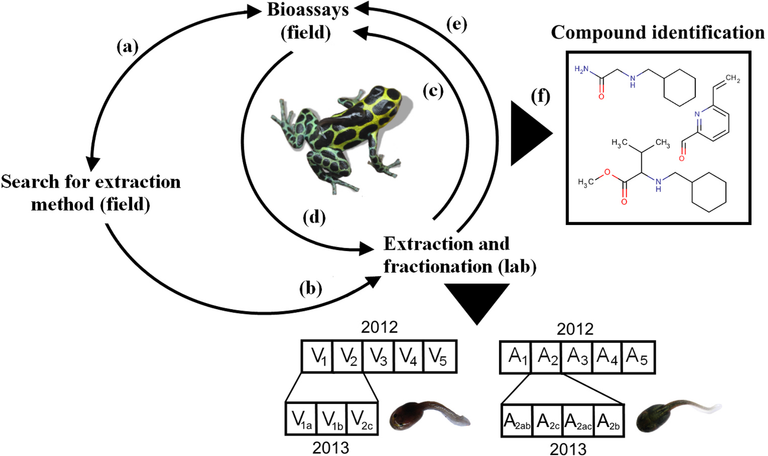
Alarming Research Results: Dramatic Threat by New Salamander Fungus
30 October 2014
A novel skin-eating fungal disease discovered in Europe poses a major threat to native salamanders and newts.
Batrachochytrium salamandrivorans (Bsal) was discovered only in 2013 by researchers investigating a remarkable decline in Fire salamander populations in the Netherlands.
New research, involving a global screening of more than 5,000 amphibians (under the lead of An Martel and Frank Pasmans from Gent University, Belgium, involving members from our group), now suggests that the new disease presents a serious threat to many species. Bsal is very dangerous to most salamanders and newts, but not to frogs, toads and the snake-like amphibians called caecilians. The fungus was also found in newts from Thailand, Vietnam and Japan as early as 1894, without causing disease, suggesting Bs originates from Southeast Asia. Watch our movie (in German).
Apparently, Bsal has arrived in Europe only recently — so far the disease has only been found in the Netherlands and Belgium, but it is likely to reach other European countries soon. In 2014, our group has started a Bsal and salamander / newt population monitoring and research program in the area in Germany close to the Belgian and Dutch outbreaks. This will be continued into 2015 and on.
Martel, A. et al. (2014): Recent introduction of a chytrid fungus endangers Western Palearctic salamanders. — Science, 346: 630-631.
Europe Needs a New Vision for a Natura 2020 Network
5 February 2013
Advocating this statement, members of our group have contributed to an important and widely acknowledged policy piece published under the interdisciplinary graduate school 'Cooperation of Science and Jurisprudence in Improving Development and Use of Standards for Environmental Protection – Strategies for Risk Assessment and Management’ at Trier University, funded by the German Science Foundation DFG (GRK 1319).
Hochkirch, A. et al. (2013): Europe needs a new vision for a Natura 2020 network. — Conservation Letters, 6: 462-476.
"Deutsche Bundesstiftung Umwelt" Book of the Month
1 February 2013
Our group has contributed to a book on the status of amphibians and reptiles under climate change at the national scale.
This work, published by the Biodiversität und Klima Forschungszentrum (BiK-F) and Climate Service Center (CSC), was honored as the book of the month in January by the 'Deutsche Bundesstiftung Umwelt', DBU.
Mosbrugger, V. et al. (2012): Klimawandel und Biodiversität. Folgen für Deutschland. — Darmstadt: WBG, 432 p.
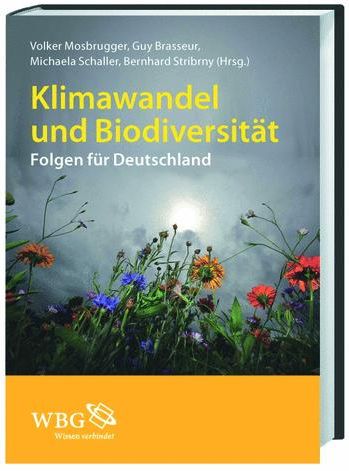
Invited Speaker to "German Zoological Society"
15 September 2012
On 24 September, Stefan Lötters will be speaking at the 105th annual meeting of the 'Deutsche Zoologische Gesellschaft' (DZG) in Konstanz on "Ecological niches in Amazonian amphibians: linking macroecology and evolution", following a kind invitation by the 'Fachgruppe Ökologie'.
Taylor Francis Prize 2011 to Lötters and colleagues
17 February 2021
Our molecular phylogeny on the critically endangered harlequin frogs (Atelopus) published in the journal Systematics and Biodiversity No 9 / 2011, was awarded the 'outstanding paper of the year' by the publisher.
Lötters, S. et al. (2011): Assessing the molecular phylogeny of a near extinct group of vertebrates: the Neotropical harlequin frogs (Bufonidae; Atelopus). — Systematics and Biodiversity, 9: 45-57.
